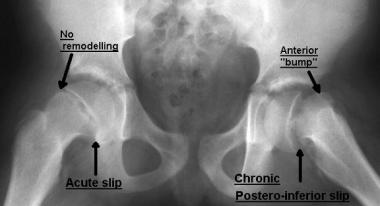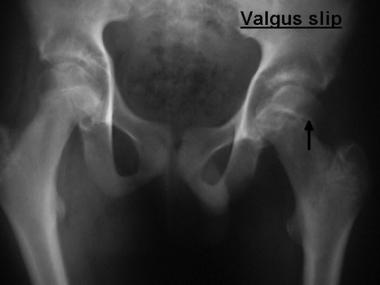

Slipped capital femoral epiphysis (SCFE) was first described by Ernst M ü ller, who called it Schenkelhalsverbiegungen im Jungesalter, meaning "bending of the femoral neck in adolescence." The term slipped capital femoral epiphysis is a misnomer because the epiphysis is held in the acetabulum by the ligamentum teres; thus, the metaphysis actually moves proximally and anteriorly while the epiphysis remains in the acetabulum. (See the image below.)
 Bilateral slipped capital femoral epiphysis. One side shows evidence of remodeling of the neck and an anterior bone bump that restricts flexion. The other side demonstrates an acute slip as seen by the absence of any evidence of remodeling.
Bilateral slipped capital femoral epiphysis. One side shows evidence of remodeling of the neck and an anterior bone bump that restricts flexion. The other side demonstrates an acute slip as seen by the absence of any evidence of remodeling.
In most patients, SCFE appears radiographically as a varus relation between the head and the neck. Occasionally, the slip appears to be in a valgus position, with the epiphysis displaced superiorly in relation to the neck.[1, 2, 3, 4, 5] In the vast majority of cases, the etiology is unknown, though atypical slips may be associated with a known endocrine disorder, with renal failure osteodystrophy, or with previous radiation therapy.[6, 7, 8, 9, 10]
NextSCFE is not life-threatening. However, untreated and complicated SCFE can lead to deformity and early osteoarthrosis of the hip and, thus, can cause considerable morbidity. Factors that increase morbidity include avascular necrosis (AVN) of the hip and chondrolysis. Both of these may result in damage severe enough to warrant a salvage procedure, in the form of an arthrodesis or a total hip arthroplasty. Prompt diagnosis is critical to prevent further deformity and AVN. The diagnosis is often subtle, and symptoms (eg, groin or knee pain) can be misleading.
The prevalence of SCFE varies widely even within the continental United States. It has been reported to be 2.13 cases per 100,000 population in the southwestern United States and 10.08 cases per 100,000 population in the northeastern United States[11] ; it is lowest in the mountain and Great Plains states. In Asia, the reported prevalence is quite low, with just 0.2 cases per 100,000 children affected in eastern Japan.[12]
A race predilection exists for SCFE, as follows[13] :
Males are affected more commonly than females are; the male-to-female ratio is 2-5:1.
The mean age at diagnosis is 13.5 years in boys (range, 13-15 years) and 12 years in girls (range, 11-13 years).[13] This corresponds to the period of maximum skeletal growth. Juvenile SCFE (in children < 10 years) should raise the suspicion of an underlying cause (eg, an endocrinopathy). Radiation-associated slips tend to occur in young children.
Various causative factors for SCFE have been identified. Factors related to body habitus include the following:
If the patient's height is below the 10th percentile, the likelihood of an underlying endocrinopathy is high.[15, 16] Endocrinopathies that may be present include the following:
Radiation therapy, especially for childhood leukemias or lymphomas, may be involved in the development of SCFE:
Finally, renal failure is an important factor:
SCFE is caused by increased stresses across a weakened physis, with a combination of both biomechanical and biochemical factors contributing to the development of the slip. Factors affecting the stability of the physis include the following:
Mechanical factors leading to increased stress across the physis[17] include the following:
SCFE is most common in the peripubertal age group; the effect of the following hormones on the physes may contribute to the likelihood of developing a slip[24] :
Even though most children with SCFE do not have an overt endocrinopathy, they may very well have some subtle endocrine disorder.[27, 28, 29, 30, 31] A delay in bone age with respect to chronologic age in some of these children lends further credence to this theory.[25, 26]
Shear stresses across a physis made vulnerable by the biomechanical and biochemical factors outlined above leads to the slip. The displacement is determined by the direction of the deforming force. Posteroinferior displacement of the head (anterosuperior migration of the neck) is the most common pattern, though in rare cases, the head may displace posterosuperiorly, giving rise to an apparent valgus slip (see the image below).[1, 2]
 Valgus slip (rare).
Valgus slip (rare).
SCFE must be considered in the differential diagnosis for children presenting with knee pain. Typically, knee examination and radiographic findings are normal in individuals with SCFE. All children with knee pain should have their hips evaluated.
Patients may present with the following symptoms:
Either side may be affected. The left hip is involved in 60% of unilateral cases. In most studies, 18-50% of cases are bilateral, though some studies have reported the prevalence of bilaterality to be as high as 80%.[32, 33, 34] Bilateral involvement may be evident at the time of initial presentation.[13] Most patients who subsequently develop a contralateral slip do so within 18-24 months of initial symptoms, though slips may occur until physeal closure.[13, 26, 32, 35, 36, 37, 38]
Management of the patient who presents with unilateral involvement is controversial. Significant morbidity can occur if the other side slips and displaces. Early recognition of a preslip on the contralateral side would help determine which patients are at greater risk. A scoring system has been developed to predict the risk of a contralateral slip.[39]
The following physical signs may be present:
Conditions to be considered in the differential diagnosis include the following:
Copyright © www.orthopaedics.win Bone Health All Rights Reserved